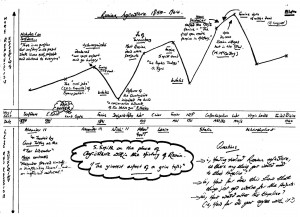We are now coming close to completing our work on agriculture.
You should now be able to cast an informed eye over my attempt to plot the relative levels of suffering for the peasants. Have I got it right ? Please post your comments (and read each others below).
This is excellent preparation for your forthcoming essay “To what extent is it correct to suggest that the treatment of Russia’s peasants was uniformly bleak in the period 1855 to 1964 ?”
One final point at this stage – before you write please remember that all the extension materials are now also arranged by theme. Just click on the Agriculture section above.
Mr Kydd.




Stolypin’s reforms could arguably not be as good as the diagram seems to show, although it is a moment of reform and the peasants seem to benefit in certain ways, e.g. the abolition of the redemption payments, it is also a moment of repression. Stolypin pursued the reforms intending to use the peasants as a bulwark against future revolts, but noticeably, he was not a great liberal reformer. A good example of this is that over 3000 suspected political revolutionaries were convicted and executed by the newly introducted court system, between 1906-1909, where the hangings became known as ‘Stolypin’s necktie.’
I agree with Sam, but I think there was period after the lateral reforms and the emancipation which saw less suffering instead of more, I also think that during serdom, there was more suffering than the graph displayed.
I think the key point here is where Sam focuses on the redemption payments. Other reforms might have been more sincere, but no other actually raised the peasants standard of living so quickly or meaningfully.
I think when you are writing about the Lateral Reforms don’t get sucked into description. Pace is the key. You might like to reflect on which of the reforms had the biggest impact on standards of living.
i’d argue that the period under Khruschev was better for peasants than is shown on the diagram. Sure the Virgin Lands plan was a disaster, but, unlike most disasters in this topic, it didn’t result in a wide scale and disastrous famine. It simply led to USSR having to import grain from Canada, which whilst embarassing must be better than Vyshnegradskii’s export and go hungry era, which on the graph seems to be on the same level of suffering as Khruschev. With the Thaw happening too, this period seems to be viewed unduly harshly on the diagram.
The other point in favour of the Virgin Lands is that we should consider its knock on impact. IE it reduced overcrowding in the Black Soil areas of Western Russia. It is of course very hard to quantify the significance of this.
I think that the NEP should be at a lower point on the diagram as I believe that the ending of grain requitioning is the reform that, over all 113 years of the course, has the best impact of the peasants’ standard of living. Before and after Lenin, grain requitioning is the main method the Autocrats use to repress the peasants, therefore to get rid of such a method created ‘the golden age of the Russian peasant’ Edward Acton.
Agreed – even if it was, as Robin suggests only “a golden age” because of the brutality and repression that straddles the NEP. Note – Robin did not use the word straddles.
I agree with Laura, that the nep should be at a Lower point on the graph. I think this because I agree with Edward acton when he says that “it was the golden age of the peasants” However I do agree with you that it should be placed higher than stolypins reforms because at least after stolypins reforms Russia had an agricultural policy 🙂
i agree with most of the diagram during the tsarist rule, however i believe that there was a higher degree of suffering during sefdom then shown due to such poor conditions the serfs had to endure on a daily basis. i also agree with the height of the famine as this was very serious due to the number of deaths and the uncertainty over how many actually died increases the severity.
I feel that the NEP was a lower point in suffering than other areas but the graph seems to suggest that suffereing is largeley diminished where it perhaps didnt have time to filter down to all parts of Russian society. Therefore i think the downward incline of the NEP shown on the graph is not entireley realistic.
I believe that serfdom during the Tsarist period carried a lot more suffering than what is shown and that Stolypin’s reforms only lessened the damage already done. Similarly, the NEP was called ‘The Golden Age of the peasents’ for the same reasons. I believe that the decline in suffering at this point only really happened for some classes of peasents, like the Kulaks, who benefited from both policies.